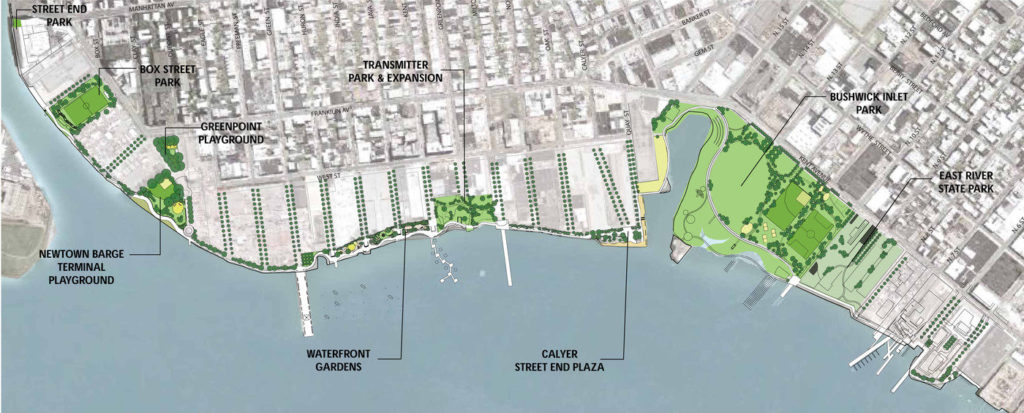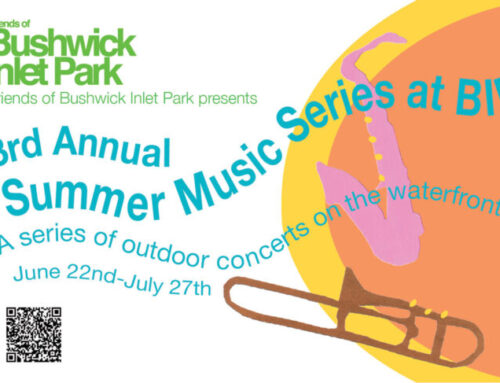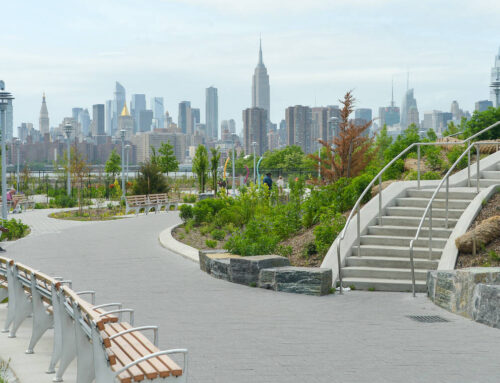Go Green BK
March 1, 2018
By Jaime Hook
A SHORT BIOGRAPHY OF BUSHWICK INLET PARK.
The story of New York City, as told by its parks, would be a colorful drama, filled with desperate characters, built on moments of both broad comedy and cliffhanging suspense. In this telling, Bushwick Inlet Park is one key player among a cast of waterfront parks that collectively hover on the edge of both North Brooklyn, and our collective imagination. Its story is one of ambition, loss, rebirth, and — finally — hope for the future.
Born out of compromise, Bushwick Inlet Park was one of the carrots offered by then-Mayor Bloomberg to the people of North Brooklyn in exchange for rolling over and playing nice with his proposed 2005 rezoning, which would open 184 blocks along the waterfront — from Navy Yard to Newtown Creek — to high-density, multi-story development. Energetically opposed by several stalwart factions of Greenpoint and Williamsburg, including our own Community Board 1, the rezoning nonetheless went into effect on May 11, 2005.
One hotly argued provision of this rezoning, pushed forth by citizen groups in the area, was that the overall plan maximize access to and use of the as-of-then underutilized waterfront. The plan asked that city- and state-owned parcels along the waterfront be activated as public parks, while private development was required to grant and maintain public access to the waterfront (as is the now the case with developments such as Williamsburg’s The Edge). Given the inevitable increase in density that the rezoning overlaid on these historically low-rise areas, this provision of open space into the space-starved zip codes of 11222 and 11211 was seen as inviolable. The ultimate goal was a walkable waterfront, stretching from Newtown Creek to the Williamsburg Bridge and beyond.
The center jewel on this waterfront necklace was to be Bushwick Inlet Park, a new 28+ acre city park cobbled together out of a half-dozen adjacent lots along the shore from North 8th all the way to Quay Street. Occupying a keystone location — adjacent to the state-owned East River State Park, embracing the inlet itself, and adjacent the historic site of the Civil war-ship Monitor — BIP was the great concession prize of the rezoning. There was only one problem: BIP was, at the time of that rezoning, little more than a phantom; its land privately owned; its benefits encumbered by environmental pollution; its provisions nothing more than a promise.
Then, the great recession of 2008 – 2009 made this promise a problem. First, as development stalled, and city coffers ran dry, Bloomberg’s procurement of the several parcels of land comprising the park receded like a fever dream. Later, as the recovery bloomed and the new zoning laws took effect, the price tag ballooned, from an estimated $60 million when first proposed, to over $190 million invested by the end of his term. When Bloomberg left office in 2014, he left the burden of procuring the final piece of land for the park — the 11-acre CitiStorage parcel right in the middle of the proposed site — to his successor, Mayor DeBlasio.
It was around this time that activists, fed-up with the protracted timeline, began to advocate in earnest for the city to make good on their 2005 promise. Led by the Friends of Bushwick Inlet Park, GWAPP, and OSA, the “Where’s Our Park” signs, flash mobs, campout-protests, and more slowly began to turn the tide of official city opinion, even as the price for the CitiStorage parcel went steadily upward.
When a 2015 fire effectively re-focussed attention on the property, things, as they say, came to a head: with eminent domain on the table, and property owner Norman Brodsky angling to maximize his sale price through a private auction, the city finally made an offer to buy this last remaining parcel in June of 2016 for $100 million. The final purchase, for $160 million, came in November of that year, bringing the total city outlays for the park close to over $400 million.
So, in the end, the promise manages to live on, albeit at multiples of the original cost estimates. But lest one cry over spilt milk, we should note that, price tag aside, the city finally has in hand the requisite land to make good on their one-time promise. The soil-remediation lawn at 50 Kent Avenue is the first hopeful sign for a new city park at that space, with plans and funds to develop the land immediately surrounding the inlet close behind.
It is into this fermenting brew of political machinations, real-estate speculation, environmental remediation, and public need and desire that the Friends of Bushwick Inlet Park are injecting much-needed leadership. Their three-part public design seminar — part history lesson, part civics course, and part design charrette — proposes to assemble and hear community voices to help cement design ideas and listen to new perspectives, as the city begins the arduous process of building out the actual Bushwick Inlet Park.
The second installment of this three-part seminar series throws down this coming Monday, March 5 at the community center at Bushwick Inlet Park. Featuring guest speakers from the worlds of design, architecture, community organizations, and the city. Guests may expect to learn more about the proposed park and the Greenpoint-Williamsburg Masterplan, and offer some input into the park’s realization. The whole park is currently slated to open to the public not before 2020 at the earliest, though parcels will come online before that time.
Steve Chesler, board member of Friends of Bushwick Inlet Park, contributed to this story.
Join Friends of Bushwick Inlet Park this coming Monday, March 5, for Envisioning Bushwick Inlet Park, Part II, the second of three planned events to help coordinate and grow public input into the design and implementation of North Brooklyn’s largest park.






